

Formative assessment with hexagons. Formative assessment is something I’ve been putting a lot more emphasis on over the past few years.
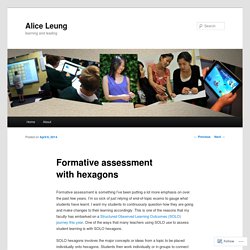
Formative assessment with hexagons. Using Exhibits as Assessment. Lesson Plans and Resources for Arts Integration. Tips for downloading: PDF files can be viewed on a wide variety of platforms -- both as a browser plug-in or a stand-alone application -- with Adobe's free Acrobat Reader program.
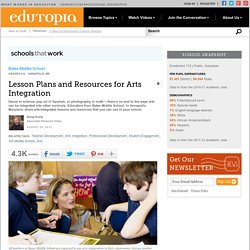
Click here to download the latest version of Adobe Reader. Lesson Plans Sample arts-integration presentations, lesson plans, quizzes, and other documents from various teachers and classes at Bates Middle School. Strategies for Teaching Reading Comprehension. Comprehension of Fiction video by The Jerry L.

Johns Literacy Clinic at Northern Illinois University Upon completion of this section, you will: Understand the components of reading comprehension Receive ideas for making the text personally relevant Learn how to teach active engagement with the text Obtain extension activities for all learning styles Traditionally, reading comprehension was narrowly thought to encompass answering some multiple-choice questions after reading a story or reading passage. Innovative Methods for Giving Students Feedback. Collaborative Mentoring for New Teachers #ISTE12. MIT Teaching and Learning Laboratory. What Are Intended Learning Outcomes?

It may be best to start with what intended learning outcomes aren’t. They aren’t simply a list of the topics to be covered in the course. Certainly, there will be a body of knowledge that students should know and understand by the time the course is complete. But if the goals for what students should achieve stops there, there may be many missed opportunities for providing them with a more productive learning experience. An intended learning outcome should describe what students should know or be able to do at the end of the course that they couldn’t do before.
Each individual intended learning outcome should support the overarching goal of the course, that is, the thread that unites all the topics that will be covered and all the skills students should have mastered by the end of the semester. SAMR. Writing Objectives Using Bloom's Taxonomy.
Various researchers have summarized how to use Bloom’s Taxonomy.
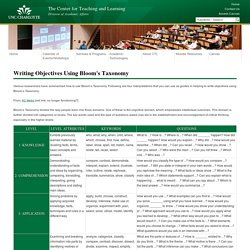
Following are four interpretations that you can use as guides in helping to write objectives using Bloom’s Taxonomy. From: KC Metro [old link, no longer functioning?] Bloom’s Taxonomy divides the way people learn into three domains. One of these is the cognitive domain, which emphasizes intellectual outcomes.
This domain is further divided into categories or levels. Strategies for Effective Lesson Planning. Stiliana Milkova Center for Research on Learning and Teaching A lesson plan is the instructor’s road map of what students need to learn and how it will be done effectively during the class time. Before you plan your lesson, you will first need to identify the learning objectives for the class meeting.
Then, you can design appropriate learning activities and develop strategies to obtain feedback on student learning. A successful lesson plan addresses and integrates these three key components: Two Examples of Taxonomies of Educational Outcomes. 19 free lesson planning resources teachers need to see. The Internet makes it easy for teachers to network, view video examples of colleagues' work and even make some money sharing their own work with others.
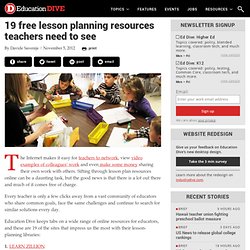
Sifting through lesson plan resources online can be a daunting task, but the good news is that there is a lot out there and much of it comes free of charge. Every teacher is only a few clicks away from a vast community of educators who share common goals, face the same challenges and continue to search for similar solutions every day. Education Dive keeps tabs on a wide range of online resources for educators, and these are 19 of the sites that impress us the most with their lesson-planning libraries: LearnZillion was created to provide support for schools, teachers and students in the nationwide transition to the Common Core Standards. Five Free Web 2.0 Tools to Support Lesson Planning. "Teachers need to integrate technology seamlessly into the curriculum instead of viewing it as an add-on, an afterthought or an event.
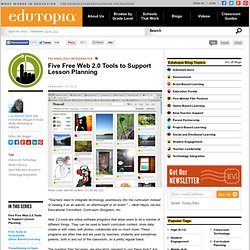
" -- Heidi Hayes Jacobs, Educational Consultant, Curriculum Designers, Inc. Web 2.0 tools are online software programs that allow users to do a number of different things. They can be used to teach curriculum content, store data, create or edit video, edit photos, collaborate and so much more. These programs are often free and are used by teachers, students and sometimes parents, both in and out of the classroom, on a pretty regular basis. The question then becomes: are educators prepared to use these tools? Are educators, especially new ones, ready to incorporate Web 2.0 tools into their classroom?
WRITING INSTRUCTIONAL OBJECTIVES. Elements of Lesson Design. Lesson Development | Lesson Planning Dr.

Madeline Hunter's research indicates that effective teachers usually include the following elements in their lessons. 1) Anticipatory Set - A short activity, dispatch or prompt that focuses the students' attention and ties previous lessons to today's lesson. 2) Purpose - An explanation of the importance of this lesson and a statement concerning what students will be able to do when they have completed it. 3) Input - The vocabulary, skills, and concepts to be learned. 4) Modeling - The teacher demonstrates what is to be learned 5) Guided Practice - The teacher leads the students through the steps necessary to perform the skill using multiple modalities. 6) Checking For Understanding - The teacher uses a variety of questioning strategies to determine if the students are understanding. The Differentiator.
Try Respondo!

→ ← Back to Byrdseed.com The Differentiator The Differentiator is based on Bloom's Taxonomy, Kaplan and Gould's Depth and Complexity, and David Chung's product menu. Try It In: French Dutch • Tweet It • Like Byrdseed • Pin It. Lesson Plan Maker. Need Tons of New Worksheets?

- 50,000+ printables - Save Time! View Now... Math and English Language Arts - 15,000+ English - 5,000+ Math.